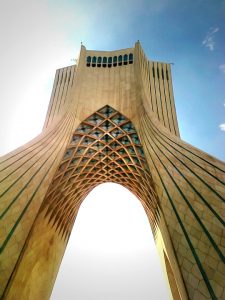By Josepha Laroche
Translation: Pierre Chabal
Passage au crible n°75

Pixabay, Téhéran
From 26 to 31 August 2012, Tehran hosted the 16th summit of the Non-Aligned Movement (NAM), which comprises today 120 member-countries. At the end of the rally, attended by 35 Heads of State and Government, the Islamic Republic of Iran took over the presidency of the Movement for the next three years.
On this occasion, Tehran undertook an extensive diplomatic and media operation designed to break its isolation on the nuclear issue and to elicit support towards its pro-Syrian policy. At this rally, were present, among others, the Secretary General of the UN Ban Ki-Moon –despite the strong reservations of Washington – the Presidents and Secretaries General of the Arab League, of the OIC (Organization of the Islamic Conference) and of the OAU (Organization of African Union), and Russian President Vladimir Putin (Russia, Invited State) and Latin American presidents Hugo Chavez (Venezuela), Evo Morales (Bolivia), and Rafael Correa (Ecuador) and Michel Temer, the vice-president of Brazil, the latter a State with observer status.
> Historical background
> Theoretical framework
> Analysis
> References
The MNA was launched in September 1961 at the Belgrade Conference. Three Heads of State, Marshal Tito (Socialist Federal Republic of Yugoslavia), Colonel Nasser (United Arab Republic/Egypt) and Nehru (Indian Republic) played a role particularly important in the creation of this organization and in its more doctrinal development. Its doctrine was then based essentially on two pillars: anti-colonialism and opposition to bipolarity. In other words, the non-alignment (NA) was defined exclusively in terms of the East-West conflict and, against the North-South gap. Member-States of the NAM have always asserted themselves – in direct line with the Bandung Conference (1955) – as the representatives and spokespersons of the South against the North.
At that time, they refused from the outset to build a permanent structure which would have the monopoly of the formulation and representation of NA and would thus establish a single and standardized non-alignment policy. Since its foundation, the NAM has taken a pragmatic approach that rejects systems of alliances in general and the two blocks in particular, while exploiting antagonisms between different State actors in the context of an active policy of mediation and oscillation.
This continued until the end of the Cold War. But after the collapse of the Soviet Union and the demise of the Eastern bloc, symbolized by the dismantling of COMECON and of the Warsaw Pact as well as by the disappearance of the People’s Democracies of Central and Eastern Europe, the NAM lost most of its raison d’être. Since then, it has undergone a significant decline. Hasn’t the balance of terror, as the founding marker of its identity that had hitherto structured international relations, given way to a more fluid and chaotic global configuration, devoid of any conceptual link with the NA? The movement has thus gone through several years of political apathy and media eclipse. However, the Tehran government now intends to put an end to this situation by working to restore its long-since lost aura.
1. By-passing the coercive diplomacy introduced by Westerners. The objective of coercive diplomacy is not to occupy territory, chasing an enemy or inflicting that enemy the greatest possible loss or destruction. Instead, the invocation of a possible coercion aims simply to spur the negotiations and haggling necessary to the more rapid implementation of a peaceful solution. In other words, it is a bargaining power. “To exploit it is diplomacy, vicious diplomacy but diplomacy still” (Thomas Schelling).
2. Raising an anti-Western diplomatic line. In order to defeat the policy of exclusion to which it is subjected, the Iran of the Mullahs intends to federate the NAM Member-States around its siege and fundamentally anti-Western vision.
Coercive diplomacy initiated several years ago by the West against the Islamic Republic of Iran is seeking to sanction the undercover development of its nuclear program in blatant violation of the provisions of the NPT (Non-Proliferation Treaty, 1968), of which Iran is a signatory. The persistent refusal by Iran to suspend its sensitive nuclear activities, as well as its refusal to shed light on its nuclear program, has been confirmed by several reports of the IAEA (International Atomic Energy Agency). Similarly, the Iranian State subtracted itself repeatedly from proposals to negotiate with the Six (E3 +3: Germany, France, United Kingdom + United States, China, Russia). This systematic blocking has thus not offered any alternative to the Security Council of the United Nations but to increase pressure on Tehran and implement sanctions (Committee on sanctions against Iran established pursuant to UN resolution 1737). For example, a strict embargo device developed by the United States and the European Union has been put in place to increase the pressure on the CBI (Central Bank of Iran) and impose to the Iranian government the giving-up of a program of nuclear weapons.
Faced with this coercion by the UN, Iran has developed a response within the Non-Aligned Movement which consists in having Iran’s positions endorsed by representatives of a very large number of States. Tehran has for example obtained that the final declaration of the NAM endorse its own reading of the nuclear issue that is the subject of such a heavy litigation. In other words – and against the unanimous opinion of all experts – the Islamic Republic has managed to validate the argument that its nuclear program would be of civilian purposes only. In addition, Iran has received recognition by NUM participants of its right to control the full nuclear cycle. However, these pronouncements amount to openly violate the prohibition, ordered to Iran by the West and by the UN, to stop its enrichment program, a ban which Russia and China, have joined themselves.
However, can we consider a real diplomatic success garnered by Iran, a success that could enable Iran to bypass – in the near future and over the long term – the ostracism to which it is being subjected? This is certainly not the case for two reasons. Firstly, its political concern to unify the NAM under its authority is mere posturing and an ephemeral display – as divisions over Syria have clearly shown –, and the Egyptian President Mohamed Morsi has not publicly hesitated to oppose Iran’s positions. Secondly, the NAM has remained permanently weakened ever since the end of the Cold War. Also, the NAM seems today more an empty shell than a spearhead. In fact, it no longer corresponds to the new international scene as the world stage is now covered in countless transnational flows and structured by complex interactions where the inter-state dimension is no longer predominant. Finally, the MNA has become an anachronistic movement and, as such, devoid of credit. Therefore, how could a state without credibility expect any salvation from it?
Hassner Pierre, « Violence, rationalité, incertitude: tendances apocalyptiques et iréniques dans l’étude des conflits internationaux », RFSP, 14 (6), déc. 1964, pp. 1019-1049.
Levy Jack, « Prospect Theory, Rational Choice and International Relations », International Studies Quarterly, 41 (1), 1997, pp. 87-112.
Schelling Thomas, Arms and Influence, New Haven, Yale University Press, 1966.
Willetts Peter, The Non-aligned Movement: the Origins of a Third World Alliance, Londres/New York, F. Printer, 1978.




